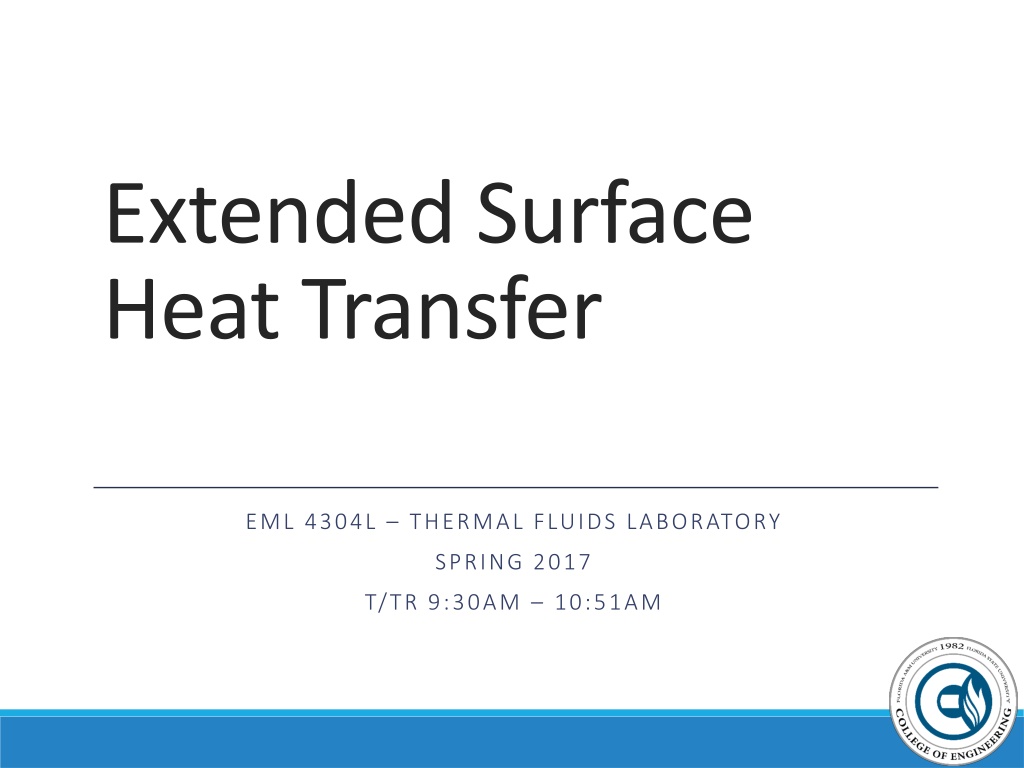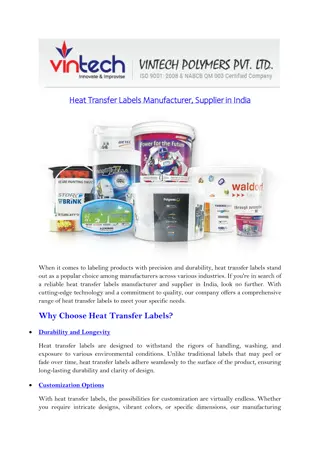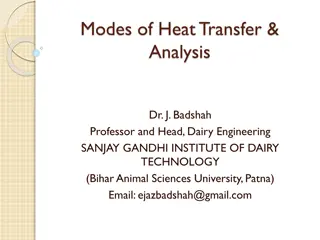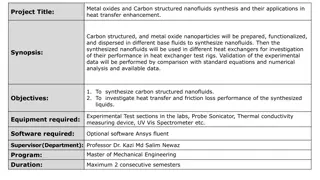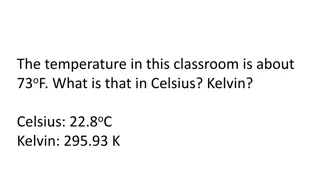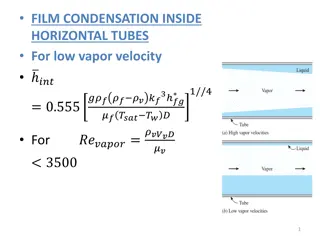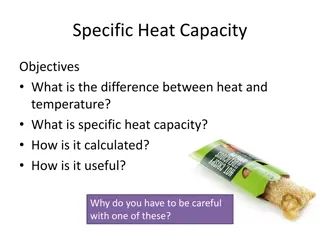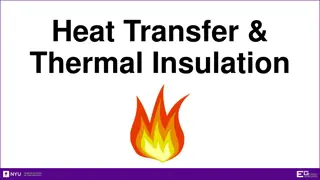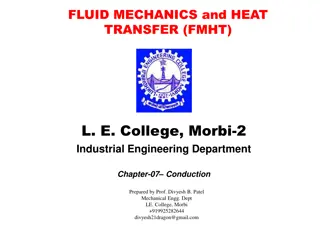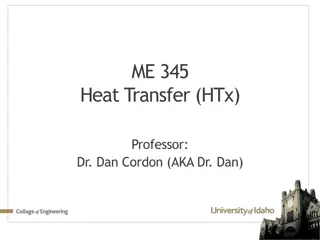Understanding Extended Surface Heat Transfer in Thermal Fluids Laboratory
This laboratory explores heat transfer in a single cylindrical extended surface (a fin) under free and forced convection to understand fin effectiveness and influencing parameters. Various types of fins like rectangular, triangular, annular, and pin fins are discussed, along with primary modes of heat transfer - conduction and convection. The efficiency of cooling fins can be improved by increasing the temperature difference, convection coefficient, fluid velocity, and contact surface area. Deriving the heat equation for a fin involves certain assumptions for setting up the problem effectively.
Download Presentation

Please find below an Image/Link to download the presentation.
The content on the website is provided AS IS for your information and personal use only. It may not be sold, licensed, or shared on other websites without obtaining consent from the author. Download presentation by click this link. If you encounter any issues during the download, it is possible that the publisher has removed the file from their server.
E N D
Presentation Transcript
Extended Surface Heat Transfer EML 4304L THERMAL FLUIDS LABORATORY SPRING 2017 T/TR 9:30AM 10:51AM
Extended Surface Heat Transfer Objectives : 1. To examine heat transfer in a single cylindrical extended surface (a fin) in free and forced convection 2. To develop an understanding of fin effectiveness and the parameters which influence it. Aluminum 6061 Fin Length, Diameter, Conduction Coefficient, Freestream Temperature, Velocity, Convection Coefficient, Constant Temperature
Extended Surfaces - Fins Fan Fin Extended surfaces or fins are generally used to enhance convective heat transfer rate between a solid and the surrounding fluid. A fin extends the surface area of heat transfer. The fin material generally has a high thermal conductivity which is exposed to a flowing fluid. Fins are often seen in electrical appliances and electronics such as on computer processors and power supplies. It is also used in industrial applications such as heat exchangers and engine cooling.
Type of Fins Rectangular Triangular Annular Pin (Cylindrical) Fins are designed and selected for a particular purpose and environment. Rectangular fins are often used in computers for cooling Annular fins are often used in heat exchangers Regardless of the shape, the heat transfer occurring in a fin is governed by the same laws. (Conduction, Convection, Radiation)
Primary Modes of Heat Transfer Conduction: Transfer of heat (internal energy) by microscopic collisions of particles and movement of electrons within a body. For a 1-D heat transfer problem, the heat flux through a specified cross sectional area can be described by Fourier s Law. Convection: Movement of groups of molecules within fluids such as liquids or gases. Involves bulk motion of fluid. Heat transfer between a solid surface and a moving fluid is governed by the Newton s law of cooling. How can the cooling efficiency be improved for a fin? Increase the temperature difference between the surface and the fluid. Increase the convection coefficient, . Change the fluid Increase velocity (forced convection coefficient) Increase the contact surface area, .
Deriving the Heat Equation for a Fin In order to setup the problem, several assumptions need to be made: Steady State Temperature is not a function of time. Material properties are constant ( and ) Independent of temperature No internal heat generation Uniform convective heat transfer coefficient over surface One dimensional (1-D) conduction Temperature at each location is uniform over Radiation is negligible
Heat Transfer for a Differential Element The Energy Equation: Internal energy is constant with time. No work is done on the system.
Heat Transfer for a Differential Element where If we rearrange the equation and divide by , we obtain: Take the limit as : Where is from Fourier s Law of Thermal Conduction. Thus, the differential equation governing heat transfer in fins is:
Expansion of Derivative Assumptions: Steady State Temperature is not a function of time. Material properties are constant ( and ) Independent of temperature No internal heat generation Uniform convective heat transfer coefficient over surface One dimensional (1-D) conduction Temperature at each location is uniform over Radiation is negligible NOTE: Both the cross sectional area, , and perimeter, , are functions of .
Simplification: Rearrange to get: If , than the equation can be reduced to: The temperature profile in a fin is governed by a 2nd order, Ordinary Differential Equation (ODE). In order to obtain a solution to the homogeneous equation we must have two boundary conditions (at the fin base and tip).
The General Solution of T(x) for a Fin ( ) Let , and In order to obtain an exact solution to the homogeneous equation, two boundary conditions (at the fin base and tip) need to be known.
Boundary Conditions (Case: Infinitely Long Fin) Boundary Conditions: 1. 2. , , Boundary Condition 2 Solution is: Boundary Condition 1
Estimate Steady State Heat Transfer (Case: Infinitely Long Fin) Heat transfer can be estimated via two methods: 1. Quantify the rate of convection over the entire surface of the fin 2. Quantify the rate of conduction from the fin base Method 2: Method 1:
Ideal Fin (Fin Efficiency) Harke What would the ideal temperature distribution for a fin? Entire fin to be at . Harke This can be thought of the limiting case of infinite thermal conductivity. The ideal (maximum) heat transfer which can occur can be calculated via Method 1. Fin Efficiency, , can be defined as the ratio of the actual heat transfer rate from the fin, ,to the ideal heat transfer rate, .
Fin Effectiveness, How to determine if a fin would be beneficial is base area Without fin With fin The fin effectiveness and fin efficiency can be related by:
Extended Surface Heat Transfer Objectives : 1. To examine heat transfer in a single cylindrical extended surface (a fin) in free and forced convection 2. To develop an understanding of fin effectiveness and the parameters which influence it. Aluminum 6061 Fin Length, Diameter, Conduction Coefficient, Freestream Temperature, Velocity, Convection Coefficient, Constant Temperature
Extended Surface Heat Transfer Experimental Procedure: 1. Measure Temperature Profile. 2. Change Velocity (Wait! Must Reach Steady State.) 3. Repeat. . . . . . . . . . . What happens when the freestream velocity is increased?
Measured Temperature Profile Derive the fin equation and general solution Calculate and plot the non-dimensional temperature profile Steady state heat transfer rate (via two methods) Which tip condition best represents the temperature distribution? Calculate the fin effectiveness and efficiency
